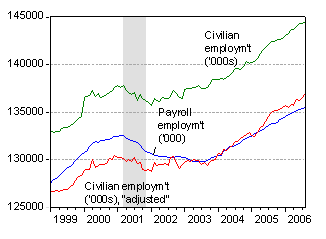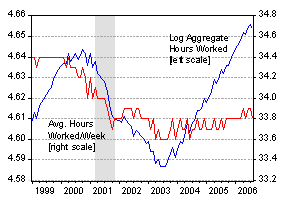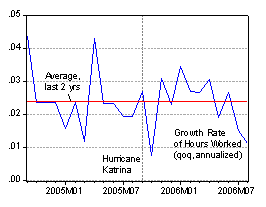Some other aspects of the employment release in context.
While the employment release has been well covered (see Calculated Risk, PGL at Angry Bear, Big Picture, knzn as well as Floyd Norris at the NYT), I thought it’d be interesting to place some of the trends in the broader context of the incipient economic slowdown.

Figure 1: Payroll employment, civilian employment and “adjusted” civilian employment trends for 1999-2006. Source: BLS, BLS, “Employment from the BLS household and payroll surveys,” (Sep. 1) and NBER recession dates.
In Figure 1, both the payroll employment and the civilian employment series, drawn from the establishment (blue line) and household surveys (green line), respectively, show gains, with those in the latter series larger than those in the former (2.1% at annual rates, versus 1.1%, using log differences). Of course, these series are not comparable for a large number of methodological reasons, discussed here. The BLS civilian employment series constructed to have similar coverage to the payroll series (listed as “adjusted” civilian employment series, red line in the figure), grew even more rapidly, at over 3%.
Time to break out the champagne? Not quite. One interesting aspect of the adjusted civilian employment series is that it can rise during a recession. This outcome reminds us that the series is calculated from a much smaller sample of households, and relies on estimates of the population which are in turn subject to large estimation errors. As previously noted, the resulting series has greater volatility than the corresponding payroll employment series based on the establishment survey.
The establishment survey also yields other interesting information that has not been remarked upon, as far as I know. As is well known, labor is hoarded — that is when economic activity declines, workers are not fired in proportion to output. This is partly why labor market indicators tend to lag, rather than lead. In any case, this phenomenon suggests we look at how intensively labor is utilized. In Figure 2 below, log aggregate hours and average hours worked per week in the non-agricultural sector are plotted.

Figure 2: Log aggregate nonfarm hours worked, and average hours worked per week, 1999-06. Source: BLS and NBER recession dates.
The figures show that average hours declined, starting in 2000, and never came close to regaining their pre-recession peaks. Right now, they stand at 33.8 hours, slightly above the trough in 2003 of 33.6, after bumping up at post-recession peaks of 33.9. More interesting to me is the aggregate hours; given rising population and labor force, this series should be trending upward over time. In the August, it fell by 2.3% at an annual rate. Of course, it has fallen in previous months, including May ’06 and August ’05 (as well as a 0 reading in October 05), so this may be a blip. However, there does appear to be a slowdown in hours worked. Figure 3 shows quarter-on-quarter annualized changes in hours worked over the past two years; the most recent comparable decline was associated with Hurricane Katrina’s aftereffects.

Figure 3: Quarter-on-quarter change in aggregate nonfarm hours worked, 2004m09-2006m08. Source: BLS and author’s calculations.
Food for thought. Especially as e-forecasting.com’s monthly GDP index shows a reading of 1.1 percent growth in August (log differences, seasonally adjusted annual rate). Does anybody know Macroeconomic Advisers’ estimate? (Although John Kitchen’s RTF-U indicator reads 3.1% growth for 2006q3.)
Technorati Tags: payroll employment,
civilian employment,hours worked
As always – excellent. Forgive me for linking to this analysis after my tirade over Lawrence Kudlow’s latest bit of dishonesty.
Macroeconomic Advisorss hasn’t published their Aug GDP forecast yet, at least according to Haver Analytics.
Worth reading
A few recent and varied pieces: * Ronald Dworkin poses Three Questions for America at the NYRB * Ben Waxman explains why students are forced to spend so much on textbooks * Menzies Chinn discusses the US labor market and the incipient slowdown * The FT…
pgl: Thanks much for the link. Keep on fighting the good fight!
GWG: Thanks for the information. We’ll have to rely on other indicators, then.